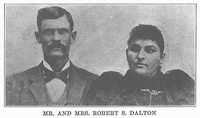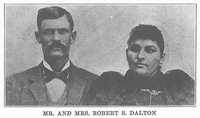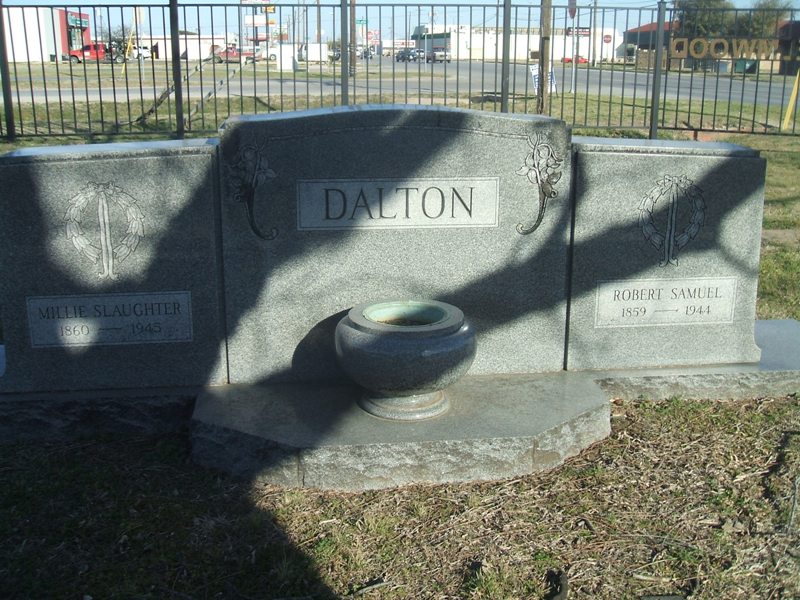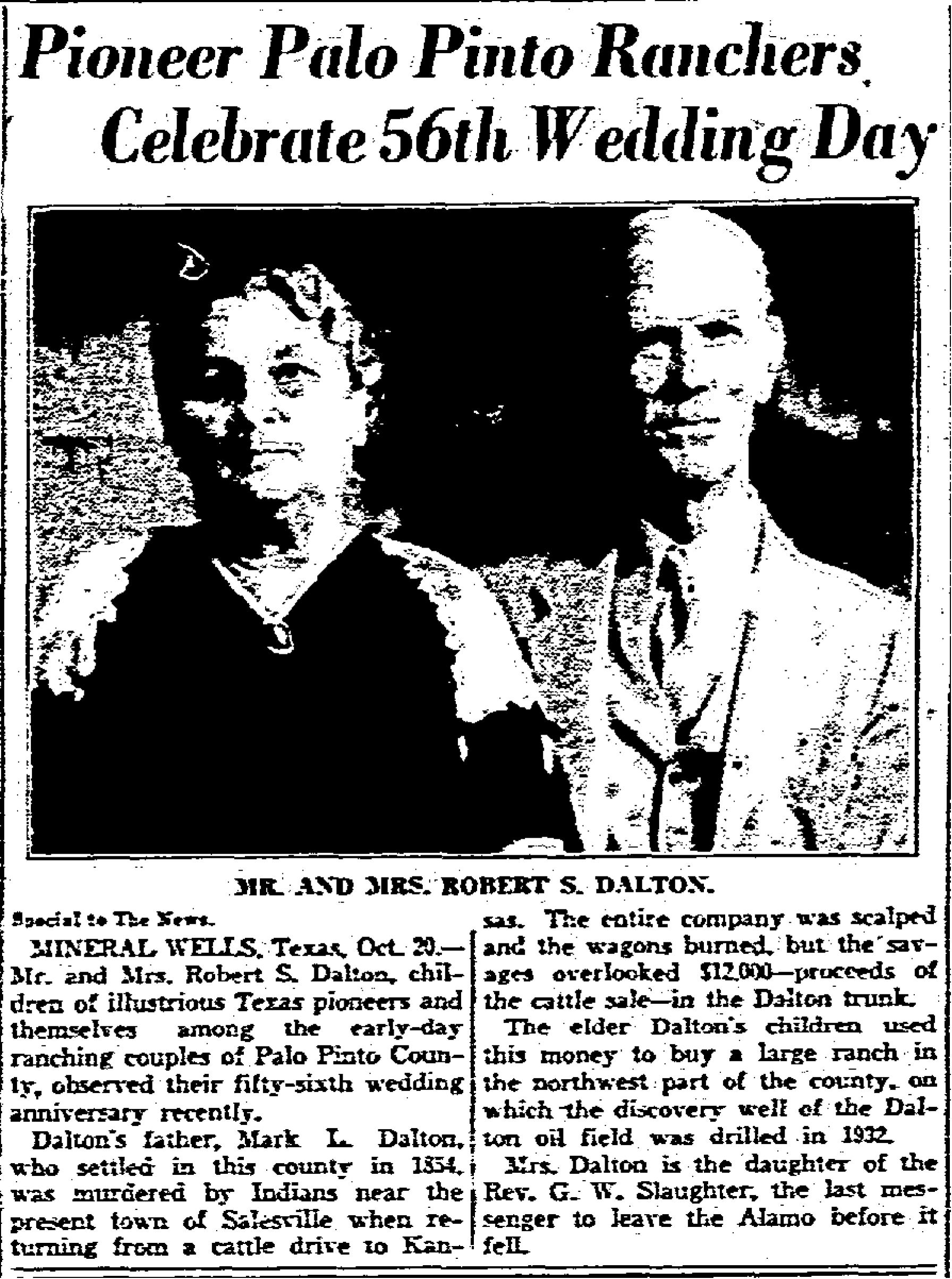~
DALTON, R. S.
R. S. Dalton is a resident of Palo Pinto County, and is a son of that grand pioneer and martyr to the cause of civilization, Marcus Lafayette Dalton.
R. S., who was born in Palo Pinto County, March 8, 1859, has pursued the calling of his father and, while but a young man, has achieved in a large measure that success and reputation which made his father's name famous in that part of Texas in the '50s and '60s.
At the time of his father's violent death at the hands of the Indians he was but a lad of eleven, and on him and his brothers devolved the duty of caring for the homestead ranch. On account of the incessant labor involved in conducting this, he was deprived of school advantages, and consequently is not a man of book education, but possesses a wide knowledge of all matters pertaining to cattle, and is well posted in affairs of the day. In connection with his brothers he carried on the ranch affairs for the space of ten years, the chief work being the care of the herds which the father had accumulated. In those days the appurtenances of the ranch were primitive, and Mr. Dalton remembers how he constructed the first saddle he ever used from an old saddle tree which he found by chance. In 1874, at the age of fifteen, his mother gave him twenty-five calves, and it was at this time that he started his brand, L. A. D., under which he has conducted all his subsequent operations. The mother has always aided her sons in obtaining a start, and four years later she presented him with 150 head more, which, added to the natural increase of his original cows, and to purchases made from time to time, gave him a total of 500 cattle.
In 1879 he was able to count as his own personal property 800 head of cattle, and thinking this an adequate start for a young man, he determined to marry and embark in the business for himself. The lady of his choice was Miss Millie Slaughter, daughter of the Rev. G. W. Slaughter, of Palo Pinto, whose biography is found elsewhere in this book. She was born in the town of Palo Pinto, December 12, 1860, and their marriage took place on October 8, 1879. So in this eventful year with his young wife and his herd of 800 cattle, and a herd of 5,000 head belonging to his mother and brothers, he moved to the Salt Fork of the Brazos River, and at the foot of the plains in Crosby County started a ranch, where they kept house in a tent and dug-out. The year following their removal to the plains G. W. Slaughter, Mrs. Dalton's father, presented her with fifty two-year-old heifers and twenty-five cows and calves, and here with their generous herds they lived for five years, selling the marketable steers and adding the increase to their herds.
To such an extent had the joint holdings of himself and wife increased, that in 1884 they were enabled to sell out their holdings for the grand total of $51,000 to the Espuela Land & Cattle Company. After this they returned to Palo Pinto County and purchased the Kyle Ranch, but receiving an offer of $6,000 for it soon afterward, he parted with it, and for the next two or three years was engaged in handling cattle, turning off from 300 to 600 steers every year.
His next transaction of note was the purchase of a ranch from his brother's wife, for which he paid $11,000, and stocked with 1,000 yearlings, and his operations here have run to about those proportions every year since. This ranch is one of exceptional beauty and fertility, the greater portion of it being located in the rich bottoms of the Brazos River, and is plentifully timbered and watered. His elegant home is located on this ranch, and its spaciousness and comfort are in striking contrast to the tent and dug-out in which they started life. A part of this ranch is in cultivation, yielding prolifically, while the balance is covered with mesquite grass, which makes the finest pasturage in the world. His other land holdings consist of 985 acres, known as the "Baker Homestead," 320 acres comprising the Graham tract, a third body of land of 2,804 acres, and a fourth of 400 acres, all located in Palo Pinto County, and not a cent of incumbrance on a single acre. In addition to his landed estate, he owns 1,000 steers, a very high grade of short horns, fifty horses, considerable town property at Mineral Wells, and $14,000 at interest. He ranks prominently among the cattlemen of his part of the State, and is a leading member of the Knights of Pythias. His interesting and accomplished wife was educated at Emporia, Kansas, and Staunton, Virginia, graduating at the latter place with high honors, and is a leader in all church and social circles of her community. The genial hospitality of Mr. and Mrs. Dalton is proverbial wherever their names are known.
Mr. Dalton relates a thrilling incident of his early boyhood which yet retains a vivid impression upon his mind. One day before the death of his father, while his brothers were out on the ranch looking after the cattle and he was at home with his mother and sisters, the Indians suddenly took possession of the premises and endeavored to force an entrance into the house. Young Dalton was only eleven at the time, but he confronted them with a pistol in his hands, and with his determined look and manner prevented access to the house. They next turned their attention to the stock and attempted to force the stable door containing the horses, but finding it locked and able to withstand their assaults, they began shooting their arrows at the beasts through the cracks, whereupon the boy fired his pistol into their midst, the report of which brought the other two brothers to the rescue. The Indians were frightened away by their approach, and the boys fired several shots after them, but without result, as they had quickly placed themselves beyond reach of bullets. (Source: Historical and Biographical Record of the Cattle Industry and the Cattlemen of Texas by James Cox, Published by Woodward & Tiernan Printing Co, St Louis, 1895
~
DALTON, R. S.
R. S. Dalton is a resident of Palo Pinto County, and is a son of that grand pioneer and martyr to the cause of civilization, Marcus Lafayette Dalton.
R. S., who was born in Palo Pinto County, March 8, 1859, has pursued the calling of his father and, while but a young man, has achieved in a large measure that success and reputation which made his father's name famous in that part of Texas in the '50s and '60s.
At the time of his father's violent death at the hands of the Indians he was but a lad of eleven, and on him and his brothers devolved the duty of caring for the homestead ranch. On account of the incessant labor involved in conducting this, he was deprived of school advantages, and consequently is not a man of book education, but possesses a wide knowledge of all matters pertaining to cattle, and is well posted in affairs of the day. In connection with his brothers he carried on the ranch affairs for the space of ten years, the chief work being the care of the herds which the father had accumulated. In those days the appurtenances of the ranch were primitive, and Mr. Dalton remembers how he constructed the first saddle he ever used from an old saddle tree which he found by chance. In 1874, at the age of fifteen, his mother gave him twenty-five calves, and it was at this time that he started his brand, L. A. D., under which he has conducted all his subsequent operations. The mother has always aided her sons in obtaining a start, and four years later she presented him with 150 head more, which, added to the natural increase of his original cows, and to purchases made from time to time, gave him a total of 500 cattle.
In 1879 he was able to count as his own personal property 800 head of cattle, and thinking this an adequate start for a young man, he determined to marry and embark in the business for himself. The lady of his choice was Miss Millie Slaughter, daughter of the Rev. G. W. Slaughter, of Palo Pinto, whose biography is found elsewhere in this book. She was born in the town of Palo Pinto, December 12, 1860, and their marriage took place on October 8, 1879. So in this eventful year with his young wife and his herd of 800 cattle, and a herd of 5,000 head belonging to his mother and brothers, he moved to the Salt Fork of the Brazos River, and at the foot of the plains in Crosby County started a ranch, where they kept house in a tent and dug-out. The year following their removal to the plains G. W. Slaughter, Mrs. Dalton's father, presented her with fifty two-year-old heifers and twenty-five cows and calves, and here with their generous herds they lived for five years, selling the marketable steers and adding the increase to their herds.
To such an extent had the joint holdings of himself and wife increased, that in 1884 they were enabled to sell out their holdings for the grand total of $51,000 to the Espuela Land & Cattle Company. After this they returned to Palo Pinto County and purchased the Kyle Ranch, but receiving an offer of $6,000 for it soon afterward, he parted with it, and for the next two or three years was engaged in handling cattle, turning off from 300 to 600 steers every year.
His next transaction of note was the purchase of a ranch from his brother's wife, for which he paid $11,000, and stocked with 1,000 yearlings, and his operations here have run to about those proportions every year since. This ranch is one of exceptional beauty and fertility, the greater portion of it being located in the rich bottoms of the Brazos River, and is plentifully timbered and watered. His elegant home is located on this ranch, and its spaciousness and comfort are in striking contrast to the tent and dug-out in which they started life. A part of this ranch is in cultivation, yielding prolifically, while the balance is covered with mesquite grass, which makes the finest pasturage in the world. His other land holdings consist of 985 acres, known as the "Baker Homestead," 320 acres comprising the Graham tract, a third body of land of 2,804 acres, and a fourth of 400 acres, all located in Palo Pinto County, and not a cent of incumbrance on a single acre. In addition to his landed estate, he owns 1,000 steers, a very high grade of short horns, fifty horses, considerable town property at Mineral Wells, and $14,000 at interest. He ranks prominently among the cattlemen of his part of the State, and is a leading member of the Knights of Pythias. His interesting and accomplished wife was educated at Emporia, Kansas, and Staunton, Virginia, graduating at the latter place with high honors, and is a leader in all church and social circles of her community. The genial hospitality of Mr. and Mrs. Dalton is proverbial wherever their names are known.
Mr. Dalton relates a thrilling incident of his early boyhood which yet retains a vivid impression upon his mind. One day before the death of his father, while his brothers were out on the ranch looking after the cattle and he was at home with his mother and sisters, the Indians suddenly took possession of the premises and endeavored to force an entrance into the house. Young Dalton was only eleven at the time, but he confronted them with a pistol in his hands, and with his determined look and manner prevented access to the house. They next turned their attention to the stock and attempted to force the stable door containing the horses, but finding it locked and able to withstand their assaults, they began shooting their arrows at the beasts through the cracks, whereupon the boy fired his pistol into their midst, the report of which brought the other two brothers to the rescue. The Indians were frightened away by their approach, and the boys fired several shots after them, but without result, as they had quickly placed themselves beyond reach of bullets. (Source: Historical and Biographical Record of the Cattle Industry and the Cattlemen of Texas by James Cox, Published by Woodward & Tiernan Printing Co, St Louis, 1895
Family Members
-
![]()
Eliza Jane "Jennie" Dalton Vollintine
1841–1918
-
![]()
John Wesley Dalton
1843–1908
-
![]()
William Cleo "Bill" Dalton
1846–1926
-
![]()
Sarah Elizabeth Dalton Denton
1847–1886
-
![]()
James Wesley Dalton
1850–1868
-
![]()
Charles Alfred Dalton Sr
1851–1934
-
![]()
George W. Dalton
1854–1889
-
![]()
Mary Lucinda Dalton Herron
1856–1924
-
![]()
General Lee Dalton
1863–1937
-
![]()
Ottie Dela Dalton Cunningham
1880–1972
-
![]()
George Webb Dalton
1883–1959
-
![]()
Marcus Lafayette "Mark" Dalton
1884–1987
-
![]()
Robbie Dalton Miller
1887–1980
-
![]()
Sallie Jane Dalton Fearis
1889–1966
-
![]()
Georgia Lee Dalton Mays
1891–1972
-
![]()
William Carroll Slaughter Dalton
1894–1980
-
![]()
Christopher Columbus Dalton
1896–1897
-
![]()
John Bell Dalton
1898–1946
-
![]()
Vivian Ruth Dalton Bruner
1901–1995
-
![]()
Leta Dalton Bennett
1903–1940
Sponsored by Ancestry
Advertisement
Explore more
Sponsored by Ancestry
Advertisement





























